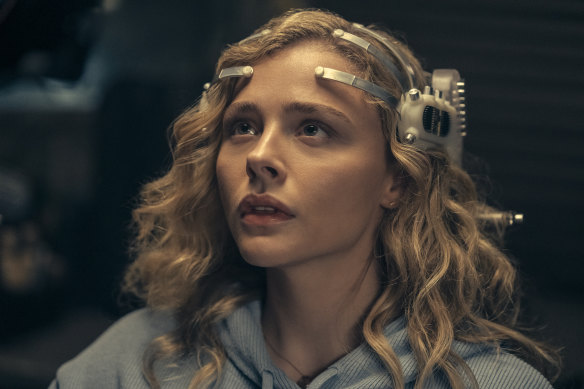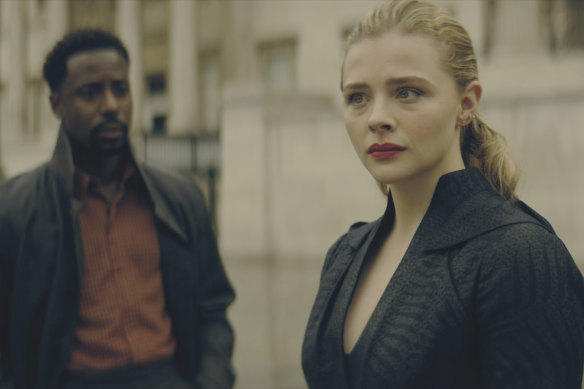The Peripheral, Amazon Prime Video (new episodes weekly on Fridays)
★★★½
About halfway through the first episode of The Peripheral, Flynne Fisher’s (Chloe Grace Moretz) brain starts to hurt. I know exactly how she feels; having watched six of the eight episodes in this sci-fi action detective story, I’m almost as confused as I was at the outset.
It may be all you need to know about this series is that Jonathan Nolan and Lisa Joy are behind it. Whether you enjoy the folding-in-upon-itself narrative of the husband-and-wife team’s Westworld will probably be a fair predictor of how you feel about this similarly Escher-like story.
Chloe Grace Moretz as Flynne Fisher in The Peripheral.Credit:Amazon Prime Video
Based on the 2014 novel by William Gibson, The Peripheral hinges upon a narrative conceit that may be a stretch for some and merely bewildering for others: everything that happens centres on a virtual reality headset that serves as a portal to the future. It makes time travel possible via data transfer.
This magical piece of hi-tech kit arrives in the mail addressed to Burton Fisher (Jack Reynor), a former Marine. He’s a gun at VR gaming – or at least that’s his reputation – and the gizmo has been sent from a company in Colombia for some beta testing.
In truth, the real expert is his sister Flynne, who earns cash rewards from the rich gamers who can’t be bothered doing the grunt work to level up.
The Peripheral is based on the 2014 novel by William Gibson.
The Fishers live in the American south 10 years from now, where work is scarce, medical treatment prohibitively expensive, 3D print shops and the illegal drug trade among the few remaining industries. Burton and his veteran buddies are linked not just by their wartime experiences and traumas; they’re literally connected via implanted nodes that allow them to sync up and operate as a highly specialised team in combat mode. But these vectors come at the cost of ongoing pain.
Has the future reached out to the siblings randomly, because of her expertise, or because of his modifications? Six episodes in, it’s still a mystery.
The “future” here is actually a couple of time zones: 2039, when the first part of a multipronged attack on the world (environmental, terrorist, viral) begins; and 2099, when technology has wrought a kind of resurrection for those lucky enough to survive.
Flynne’s first headset experience takes her deep into the latter, though she’s in Burton’s physical form. She assumes it’s merely a digital avatar, albeit one with amazing haptics that allow her to feel her environment, and her (or his) body. But it soon becomes clear that this body actually exists – it’s 3D printed and organic, rather like the hosts in Westworld, and it’s the “peripheral” of the title – as does the world into which she’s stumbled.
What’s more, the piece of industrial espionage in which she has become entangled – imagining it was no more than a game – has real-world consequences too, in her time zone as well as the future.
If your head is reeling from this brief potted description, that’s probably as the show’s creators would have wished. It’s a brain puzzle, a maze (there’s that Westworld echo again), in which the real and the fabricated are entirely enmeshed. It’s the sort of storytelling that demands effort; whether it rewards it, I honestly can’t yet say.
The Peripheral is on Amazon Prime Video from October 21.
Email the author at [email protected], or follow him on Facebook at karlquinnjournalist and on Twitter @karlkwin.
Find out the next TV, streaming series and movies to add to your must-sees. Get The Watchlist delivered every Thursday.
Most Viewed in Culture
From our partners
Source: Read Full Article








